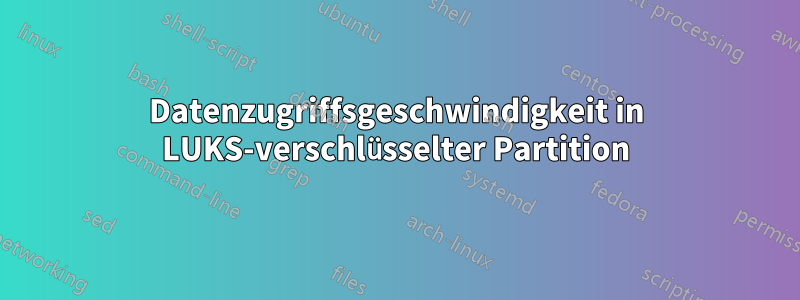
Unter Linux (Fedora 28) habe ich mein Home-Verzeichnis LUKS verschlüsselt. Wenn ich Gnome Disk verwende (Screenshot), kann ich die zugrunde liegende LUKS-Partition (oberes blaues Rechteck) und die entschlüsselte Home-Partition (unteres weißes Rechteck) separat vergleichen.
Die LUKS-Partition bietet eine Zugriffszeit von 500 MB/s, der entschlüsselte Zugriff jedoch 350 MB/s. Um es klarzustellen: Dies ist dieselbe Partition wie eine 500 GB große SSD.
Ist es fair zu folgern, dassVerschlüsselungverlangsamt den Datenzugriff um 30 % (= 150/500)?
Ist diese Art von Nummer dokumentiert oder mache ich etwas falsch? Das ist eine viel größere Verlangsamung, als ich erwartet hatte.
BEARBEITEN:Dies ist meine Ausgabe für
$ cryptsetup benchmark
# Tests are approximate using memory only (no storage IO).
PBKDF2-sha1 384375 iterations per second for 256-bit key
PBKDF2-sha256 494611 iterations per second for 256-bit key
PBKDF2-sha512 323634 iterations per second for 256-bit key
PBKDF2-ripemd160 293225 iterations per second for 256-bit key
PBKDF2-whirlpool 185917 iterations per second for 256-bit key
argon2i 4 iterations, 748334 memory, 4 parallel threads (CPUs) for 256-bit key (requested 2000 ms time)
argon2id 4 iterations, 745443 memory, 4 parallel threads (CPUs) for 256-bit key (requested 2000 ms time)
# Algorithm | Key | Encryption | Decryption
aes-cbc 128b 195.0 MiB/s 664.0 MiB/s
serpent-cbc 128b 28.8 MiB/s 94.7 MiB/s
twofish-cbc 128b 58.8 MiB/s 111.6 MiB/s
aes-cbc 256b 146.5 MiB/s 507.3 MiB/s
serpent-cbc 256b 33.3 MiB/s 110.2 MiB/s
twofish-cbc 256b 59.3 MiB/s 123.6 MiB/s
aes-xts 256b 433.7 MiB/s 416.8 MiB/s
serpent-xts 256b 101.0 MiB/s 94.7 MiB/s
twofish-xts 256b 111.8 MiB/s 110.3 MiB/s
aes-xts 512b 349.5 MiB/s 356.6 MiB/s
serpent-xts 512b 101.6 MiB/s 96.0 MiB/s
twofish-xts 512b 111.2 MiB/s 108.1 MiB/s
$ lscpu | grep aes
Flags: fpu vme de pse tsc msr pae mce cx8 apic sep mtrr pge
mca cmov pat pse36 clflush dts acpi mmx fxsr sse sse2 ss ht tm pbe syscall
nx rdtscp lm constant_tsc arch_perfmon pebs bts rep_good nopl xtopology
nonstop_tsc cpuid aperfmperf pni pclmulqdq dtes64 monitor ds_cpl vmx est
tm2 ssse3 cx16 xtpr pdcm pcid sse4_1 sse4_2 x2apic popcnt tsc_deadline_timer
aes xsave avx f16c rdrand lahf_lm cpuid_fault epb pti ssbd ibrs ibpb stibp
tpr_shadow vnmi flexpriority ept vpid fsgsbase smep erms xsaveopt dtherm
ida arat pln pts flush_l1d
BEARBEITEN 2020:Ich habe meinen Computer gewechselt und erhalte beim Krypto-Benchmark völlig andere Ergebnisse, die weit über das hinausgehen, was durch einen schnelleren Prozessor erklärt werden kann. Ich denke also, dass meine alte Hardware nicht über den dedizierten Verschlüsselungschip verfügte:
$ cryptsetup benchmark
# Tests are approximate using memory only (no storage IO).
PBKDF2-sha1 1756408 iterations per second for 256-bit key
PBKDF2-sha256 2264742 iterations per second for 256-bit key
PBKDF2-sha512 1653905 iterations per second for 256-bit key
PBKDF2-ripemd160 949797 iterations per second for 256-bit key
PBKDF2-whirlpool 711381 iterations per second for 256-bit key
argon2i 8 iterations, 1048576 memory, 4 parallel threads (CPUs) for 256-bit key (requested 2000 ms time)
argon2id 8 iterations, 1048576 memory, 4 parallel threads (CPUs) for 256-bit key (requested 2000 ms time)
# Algorithm | Key | Encryption | Decryption
aes-cbc 128b 1256.4 MiB/s 3669.2 MiB/s
serpent-cbc 128b 101.6 MiB/s 771.8 MiB/s
twofish-cbc 128b 230.0 MiB/s 418.4 MiB/s
aes-cbc 256b 947.9 MiB/s 2961.6 MiB/s
serpent-cbc 256b 105.1 MiB/s 785.0 MiB/s
twofish-cbc 256b 235.7 MiB/s 424.5 MiB/s
aes-xts 256b 2209.9 MiB/s 2218.9 MiB/s
serpent-xts 256b 762.0 MiB/s 776.6 MiB/s
twofish-xts 256b 415.7 MiB/s 384.0 MiB/s
aes-xts 512b 1701.8 MiB/s 1677.2 MiB/s
serpent-xts 512b 713.7 MiB/s 769.6 MiB/s
twofish-xts 512b 407.9 MiB/s 414.2 MiB/s
Antwort1
Die Verschlüsselung verursacht zusätzliche CPU-Last, da jeder Festplattenblock beim Zugriff vom Betriebssystem entschlüsselt werden muss. Ihre Testergebnisse (~600 MB/s Entschlüsselung) sind für die generische AES-Verarbeitung auf einem i7 ziemlich durchschnittlich.
Um dieses Problem zu vermeiden, verfügen moderne CPUs im Allgemeinen über eine integrierte hardwarebasierte AES-Unterstützung. Intel nennt diese Funktion „AES-NI“ (dargestellt als lscpu„aes“) und sie ermöglicht Geschwindigkeiten von 2–3 GB/s für dieselbe AES-Entschlüsselung.
Führen Sie es zunächst aus lscpuund prüfen Sie, ob "aes" unter den Feature-Flags erwähnt wird.Intel ARKzeigt an, dass es in Ihrem CPU-Modell vorhanden ist, aber es kann durch die Firmware-Einstellungen (BIOS) deaktiviert sein. (Die ARK hat eine Fußnote:„Einige Produkte können AES New Instructions mit einem Update der Prozessorkonfiguration unterstützen … Wenden Sie sich für das BIOS mit dem neuesten Update der Prozessorkonfiguration bitte an den OEM.“)
Linux verwendet das Modul „aesni_intel“, um die Hardwarebeschleunigung zu aktivieren. Überprüfen Sie, ob es in Ihrem Kernel überhaupt aktiviert ist, indem Sie ausführen zgrep AES_NI_INTEL /proc/config.gz. Wenn „ “ angezeigt wird =y, ist es Teil des Haupt-Kernel-Images und sollte verfügbar sein.
Wenn die Ausgabe " =m" anzeigt, wurde es als Modul kompiliert. Versuchen Sie, das Modul manuell zu laden, indem Sie ausführen sudo modprobe -v aesni_intel. Wenn der Befehl das Modul nicht finden kann, müssen Sie wahrscheinlich neu starten. (Stellen Sie nach dem Neustart sicher, dass uname -rdieselbe Kernelversion wie in angezeigt wird ls /lib/modules.)



